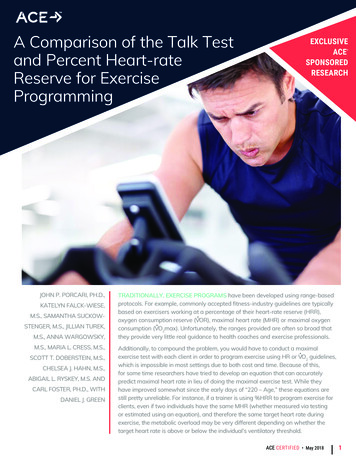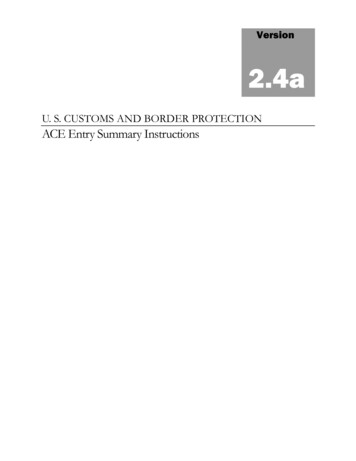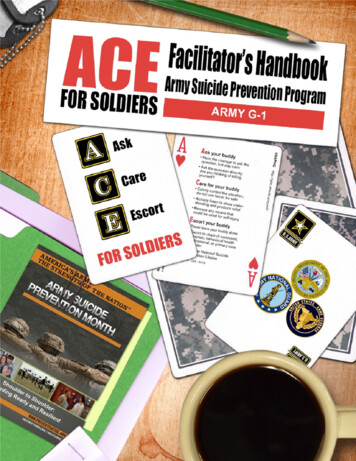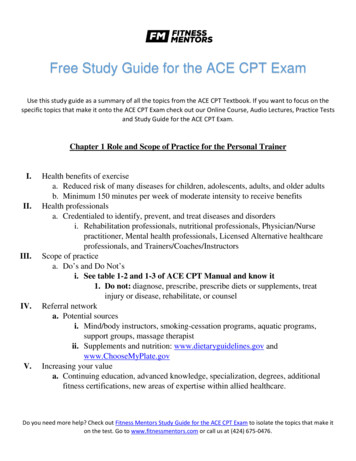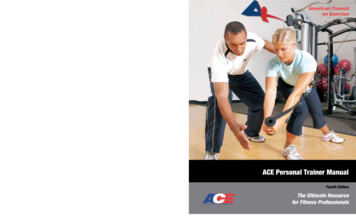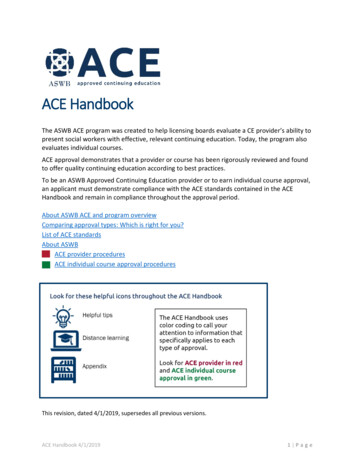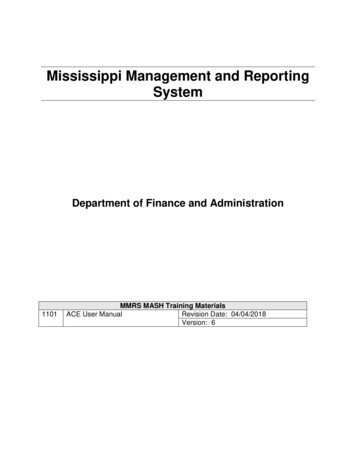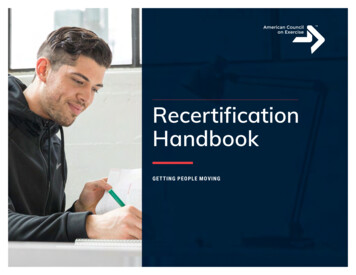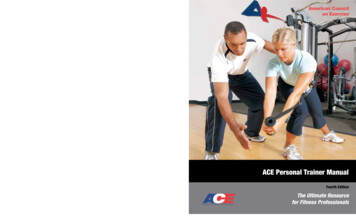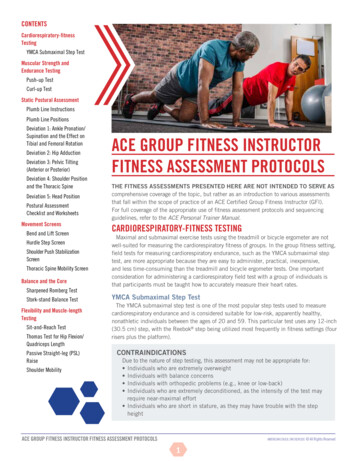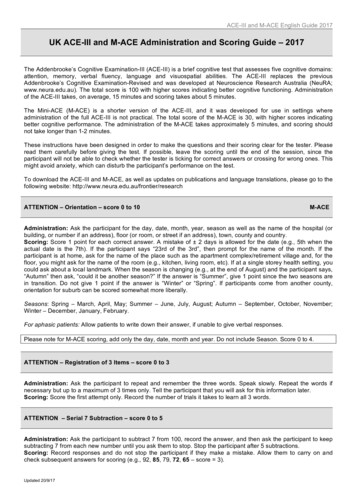
Transcription
ACE-III and M-ACE English Guide 2017UK ACE-III and M-ACE Administration and Scoring Guide – 2017The Addenbrooke’s Cognitive Examination-III (ACE-III) is a brief cognitive test that assesses five cognitive domains:attention, memory, verbal fluency, language and visuospatial abilities. The ACE-III replaces the previousAddenbrooke’s Cognitive Examination-Revised and was developed at Neuroscience Research Australia (NeuRA;www.neura.edu.au). The total score is 100 with higher scores indicating better cognitive functioning. Administrationof the ACE-III takes, on average, 15 minutes and scoring takes about 5 minutes.The Mini-ACE (M-ACE) is a shorter version of the ACE-III, and it was developed for use in settings whereadministration of the full ACE-III is not practical. The total score of the M-ACE is 30, with higher scores indicatingbetter cognitive performance. The administration of the M-ACE takes approximately 5 minutes, and scoring shouldnot take longer than 1-2 minutes.These instructions have been designed in order to make the questions and their scoring clear for the tester. Pleaseread them carefully before giving the test. If possible, leave the scoring until the end of the session, since theparticipant will not be able to check whether the tester is ticking for correct answers or crossing for wrong ones. Thismight avoid anxiety, which can disturb the participant’s performance on the test.To download the ACE-III and M-ACE, as well as updates on publications and language translations, please go to thefollowing website: http://www.neura.edu.au/frontier/researchATTENTION – Orientation – score 0 to 10M-ACEAdministration: Ask the participant for the day, date, month, year, season as well as the name of the hospital (orbuilding, or number if an address), floor (or room, or street if an address), town, county and country.Scoring: Score 1 point for each correct answer. A mistake of 2 days is allowed for the date (e.g., 5th when theactual date is the 7th). If the participant says “23rd of the 3rd”, then prompt for the name of the month. If theparticipant is at home, ask for the name of the place such as the apartment complex/retirement village and, for thefloor, you might ask for the name of the room (e.g., kitchen, living room, etc). If at a single storey health setting, youcould ask about a local landmark. When the season is changing (e.g., at the end of August) and the participant says,“Autumn” then ask, “could it be another season?” If the answer is “Summer”, give 1 point since the two seasons arein transition. Do not give 1 point if the answer is “Winter” or “Spring”. If participants come from another county,orientation for suburb can be scored somewhat more liberally.Seasons: Spring – March, April, May; Summer – June, July, August; Autumn – September, October, November;Winter – December, January, February.For aphasic patients: Allow patients to write down their answer, if unable to give verbal responses.Please note for M-ACE scoring, add only the day, date, month and year. Do not include Season. Score 0 to 4.ATTENTION – Registration of 3 Items – score 0 to 3Administration: Ask the participant to repeat and remember the three words. Speak slowly. Repeat the words ifnecessary but up to a maximum of 3 times only. Tell the participant that you will ask for this information later.Scoring: Score the first attempt only. Record the number of trials it takes to learn all 3 words.ATTENTION – Serial 7 Subtraction – score 0 to 5Administration: Ask the participant to subtract 7 from 100, record the answer, and then ask the participant to keepsubtracting 7 from each new number until you ask them to stop. Stop the participant after 5 subtractions.Scoring: Record responses and do not stop the participant if they make a mistake. Allow them to carry on andcheck subsequent answers for scoring (e.g., 92, 85, 79, 72, 65 – score 3).Updated 20/9/17
ACE-III and M-ACE English Guide 2017MEMORY – Recall of 3 Items – score 0 to 3Administration: Ask the participant to recall the words that you asked them to repeat and remember earlier.Scoring: Record responses and score 1 point for each correct item. Do not prompt the participant for the items.VERBAL FLUENCY – Letter – score 0 to 7Administration: Tell the participant: “I’m going to give you a letter of the alphabet and I’d like you to generate asmany words as you can beginning with that letter, but not names of people or places. For example, if I give you theletter “C”, you could give me words like “cat, cry, clock” and so on. But, you can’t give me words like Catherine orCanada. Do you understand? Are you ready? You have one minute. The letter I want you to use is the letter “P”.Scoring: First, record the total number of words that the participant generates. Then, count the total number ofcorrect words, which do not include: (1) repetitions, (2) perseverations (e.g., pay, paid, pays – score 1), (3)intrusions (i.e., words beginning with other letters), (4) proper names (i.e., names of people or places) and (5) plurals(e.g., pot, pots – total 2, correct 1). Use the table provided on the ACE-III sheet to obtain the final score for thistest.VERBAL FLUENCY – Animals – score 0 to 7M-ACEAdministration: Tell the participant: “Now can you name as many animals as possible. It can begin with any letter.”Scoring: Again, record the total number of animals that the participant generates. Then, count the total number ofcorrect words, which do not include higher order categories when specific exemplars are given (e.g., “fish” followedby “salmon” and “trout” – total 3; correct 2). No points are given for different sex/genders are given for the sametype of animal (e.g., “deer” followed by “doe, fawn, stag” scores only 1 point). All types of animals are accepted,including insects, humans, prehistoric, extinct as well as mythical creatures (e.g., unicorn). If the participantmisunderstands the instructions and perseverates by naming animals beginning with “p” (e.g., panda, possum,platypus etc), then reiterate to the participant that they should name animals beginning with any letter.MEMORY – Anterograde Memory – Name and Address – score 0 to 7M-ACEAdministration: Instruct the participant: “I’m going to give you a name and address and I’d like you to repeat thename and address after me. So you have a chance to learn, we’ll be doing that 3 times. I’ll ask you the name andaddress later.” If the participant starts repeating along with you, ask them to wait until you give it in full.Scoring: Record responses for each trial but only responses in the third trial contributes to the ACE-III score (07points).MEMORY – Retrograde Memory – Famous People – score 0 to 4Administration: Ask the participant for the name of the current Prime Minister, the first female Prime Minister, thepresident of the USA and the president of the USA who was assassinated in the 1960s.Scoring: Score 1 point each. Allow surnames (e.g., “Obama”) and ask for a surname if only the first name is given(e.g., “Maggie”). If the full name given is incorrect (e.g., “June Thatcher”), then the score would be 0. If there hasbeen a recent change in leaders, probe for the name of the outgoing politician.LANGUAGE – Comprehension – score 0 to 3Administration: Place a pencil and a piece of paper in front of the participant. As a practice trial, ask the participantto “pick up the pencil and then the paper”. If this is incorrectly performed, score 0 and do not continue any further.Otherwise, continue onwards with the three other commands listed on the protocol. Before beginning each trial,always place the pencil and piece of paper in front of the participant.Scoring: A score of 1 is given for each command performed correctly.Updated 20/9/17
ACE-III and M-ACE English Guide 2017LANGUAGE – Sentence Writing – score 0 to 2Administration: Ask the participant to write two sentences and suggest a few topics (e.g., recent holiday, hobbies,family or childhood) if they are unable to come up with anything to write. Importantly, if the participant writes only onesentence, prompt for a second.Scoring: Sentences must have a subject and a verb. We are looking for spelling and grammar errors. Sentences donot need to be about the same topic; they can be unrelated. If a patient can only write one sentence, despiteprompting, then this will be penalized.PointsDescription of Sentence2Two sentences with no errors in grammar or spelling. Note that sentences do not need to be centredon the one topic.E.g., “I like to go to the beach. I have three grandchildren.”1Two sentences with either incorrect grammar or spelling.One sentence with correct grammar and spelling.E.g., “I like to go to the beech. I also like dancing.”“I like go beach. I like dance.”I like swimming.” (The patient does not write another sentence despite prompting)0One sentence with incorrect grammar and/or spelling.A few words that is a phrase (e.g., “like dancing”), place (e.g., “Royal Hospital” or a person’s name.Unable to write a sentenceLANGUAGE – Single Word Repetition – score 0 to 2Administration: Ask the participant to repeat each word after you, saying only one word at a time.Scoring: If the repetition does not sound normal (e.g., halting, laboured, slurred) then it is incorrect. Only the firstattempt is scored. Score 2 if all words are correct; 1 if only 3 are correct; 0 if 2 or less are correct.LANGUAGE – Proverb Repetition – score 0 to 2Administration: Ask the participant to repeat each proverb.Scoring: Do not accept partially correct repetitions (e.g., “all that glistens is not gold”). Score 1 point for eachproverb.Note: Following the repetition of each proverb, the examiner may wish to ask the participant “What does this proverbmean?” or “How would you explain this proverb to someone who has not heard it before?” This additional measurecan aid the clinician in the qualitative assessment of verbal abstract thinking.Updated 20/9/17
ACE-III and M-ACE English Guide 2017LANGUAGE – Object Naming – score 0 to 12Administration: Ask the participant to name each picture.Scoring: Correct answers are: spoon; book; penguin; anchor; camel or dromedary; barrel, keg, or tub; crown;crocodile or alligator; harp; rhinoceros or rhino; kangaroo or wallaby; piano accordion, accordion or squeeze box.Score 1 point for each item.LANGUAGE – Comprehension – score 0 to 4Administration: Ask the participant to point to the pictures according to the statement read. Do not provide anyfeedback regarding the word meaning.Scoring: Score 1 point for each item. Self-corrections are allowed.LANGUAGE – Reading – score 0 or 1Administration: Ask the participant to read the words aloud.Scoring: Score 1 point if all five words are read correctly. Record the mistakes using the phonetic alphabet, ifpossible.VISUOSPATIAL ABILITIES – Intersecting Infinity Loops – score 0 or 1Administration: Ask the participant to copy the intersecting infinity loops.Scoring: A score of 1 is given if two infinity loops are drawn and overlap. Both infinity loops must come to apoint/cross and do not look like circles.Score 0Score 1Updated 20/9/17
ACE-III and M-ACE English Guide 2017VISUOSPATIAL ABILITIES – 3D Wire Cube – score 0 to 2Administration: Ask the participant to copy the 3-D wire cube.Scoring: The cube should have 12 lines to score 2 points, even if the proportions are not perfect. A score of 1 isgiven if the cube has fewer than 12 lines but a general cube shape is maintained.Score 1Score 2VISUOSPATIAL ABILITIES– Clock – score 0 to 5M-ACEAdministration: Ask the participant to draw a clock face with numbers on it. When he/she has finished, ask them toput the hands at “ten past five”. If the participant does not like their first drawing and would like to do it again, youcan allow for that and score the second clock. Participants may correct their mistakes by erasing it while drawing.Scoring: The following scoring criteria are used below to give a total of 5 points.Circle1 point maximum if it is a reasonable circleNumbers2 points if all numbers are included within the circle and numbers are evenly distributed. A slightrotation to the overall clock face is acceptable.1 point if all numbers are included but the numbers are either outside of the circle or the numbers areunevenly spaced0 points if not all numbers are includedHands2 points if both hands are drawn, lengths are correct and placed on correct numbers (you might askwhich one is the small and big one)1 point if both hands are drawn and placed on the correct numbers but lengths are incorrectUpdated 20/9/17
ACE-III and M-ACE English Guide 20171 point if both hands are drawn but only one hand is placed on the correct number and drawn withcorrect length0 points if two hands are drawn but both lengths incorrect and one number is correct0 point if two hands are drawn but both lengths and numbers are incorrect0 point if one hand is drawnScore 1Score 2Score 2Circle (1); not clear that all numbers arepresent (0); not clear where the handsare positionedCircle (1); one hand placed on thecorrect number and has the correctlength (1)Circle (1); all the numbers butnot placed inside the circle (1)Score 2Score 3Score 3Circle (1); all the numbers but notplaced inside the circle (1); two handswith one number correct but lengthsare even (0)Circle (1); all the numbers present andproportionally distributed (a slightrotation of the whole clock face is OK)(2); one hand only (0)Circle (1); numbers are notinside the circle and there are2 number 10s (0); handsplaced correctly and correctlengths (2)Score 3Score 4Score 4Circle (1); numbers are unevenlyspaced (1); one hand placed correctlyand has the correct length (1)Circle (1); all the numbers but notproportionally distributed (1); bothhands placed correctly and has thecorrect length (2)Circle (1); numbers areproportionally distributed (2);one hand placed correctly andhas the correct length (1)Updated 20/9/17
ACE-III and M-ACE English Guide 2017Score 5Circle (1); numbers proportionally distributed on both halves of the clock face (2); hands placed correctly (2)PERCEPTUAL ABILITIES – Counting Dots – score 0 to 4Administration: Ask the participant for the number of dots in each square. The participant is not allowed to point.Scoring: Score 1 point for each correct answer. Correct answers: 8, 10, 9 and 7.PERCEPTUAL ABILITIES – Identifying Letters – score 0 to 4Administration: Ask the participant to identify the letter in each square. The participant is allowed to point.Scoring: Score 1 point for each correct answer. Correct answers: K, M, T and A.For aphasic patients: If the participant is unable to say the number of dots or letter name, allow them to write theiranswer. For the letter, allow them to say the correct letter sounds (e.g., “mmm”).MEMORY – Recall of Name and Address – score 0 to 7M-ACEAdministration: Say to the participant: “Now tell me what you remember of that name and address we wererepeating at the beginning”.Scoring: Score 1 point for each item recalled, using the score guide provided in the test.Harry Barnes73 Orchard CloseKingsbridgeDevonExample: 1aHarry Bond78 Orchard CloseKingsbury .Example: 2aHarry Barnes73 Kingsbridge Close .DevonExample: 3aHarry Bond33 Kingsbury WayKingsbridge CloseCambridgeDevonUpdated 20/9/171 00 1 100Score 3/71 11 0 101Score 5/71 00 0 00 001Score 2/7
ACE-III and M-ACE English Guide 2017MEMORY – Recognition of Name and Address – score 0 to 5Administration: This condition is given to participants if they fail to recall one or more items in the Recall condition.This task is given to allow the participant a chance to recognise items that he/she could not recall. If all of the itemsin the name and address are correctly recalled, this condition is not needed and the participant automatically scores5 points. However, many participants will recall only parts of the name and address. First, tick the correctlyremembered items on the shaded column (right hand side) and then tell the participant, “Let me give you some hints.Was it x, y or z?” and so on.Scoring: Every item recognised correctly scores 1 point. Add the correctly recalled and recognised item to give atotal of 5 points for this condition.Example 1b (based on example 1a)Tester ticks “Orchard Close” on the right hand sideshadowed column because participant had recalledthat item. The tester should then ask:- Was it Jerry Barnes, Harry Barnes or HarryBradford?- Was it 37, 73 or 76?- Was it Oakhampton, Kingsbridge or Dartington?- Was it Devon, Dorset or Somerset?Participant’sanswers:Harry Barnes176KingsbridgeDorset010 1 (Orchard Close)Score 3/5Example 2b (based on example 2a)Tester ticks “Harry Barnes”, “73” and “Devon” on theright hand side shadowed column because participanthad recalled those items. The tester should then ask:- Was it on Orchard Place, Oak Close or OrchardClose?- Was it Oakhampton, Kingsbridge or Dartington?Participant’sanswers:Orchard Close1Kingsbridge1 3 (Harry Barnes, 73, Devon)Score 5/5Example 3b (based on example 3a)Tester ticks “Devon”, on the right hand side shadowedcolumn because participant had recalled that item. Thetester should then ask:- Was it Jerry Barnes, Harry Barnes or HarryBradford?- Was it 37, 73 or 76?- Was it Orchard Place, Oak Close or OrchardClose?- Was it Oakhampton, Kingsbridge or Dartington?Participant’sanswers:Jerry Barnes037Orchard Place00Oakhampton0 1 (Devon)Score 1/5S C O R E S – Domain and Total Score of the ACE-IIIScoring: Sum the items for each of the five domains (attention, memory, fluency, language and visuospatial) to givethe Domain Scores for the ACE-III. The Total ACE-III score (/100) consists of the sum of the five domain scores.Sum together the shaded boxes for the Mini-ACE score (/30). Note: The Orientation score for the Mini-ACE is scoredout of a maximum of 4 only; the Season item is not included.For the ACE-III, the same cut-off scores as the ACE-R of 88 and 82 out of 100 are recommended for suspicion ofdementia. Similarly, cut-off scores of 25 and 21 out of 30 are recommended for the M-ACE. The cut-off that is useddepends on the sensitivity and specificity required for the context in which these measures are implemented (e.g.Updated 20/9/17
ACE-III and M-ACE English Guide 2017clinical or research settings). See table below for details regarding the sensitivity and specificity of these ed 20/9/17
ACE-III and M-ACE English Guide 2017 Updated 20/9/17 LANGUAGE - Sentence Writing - score 0 to 2 Administration: Ask the participant to write two sentences and suggest a few topics (e.g., recent holiday, hobbies, family or childhood) if they are unable to come up with anything to write. Importantly, if the participant writes only one
